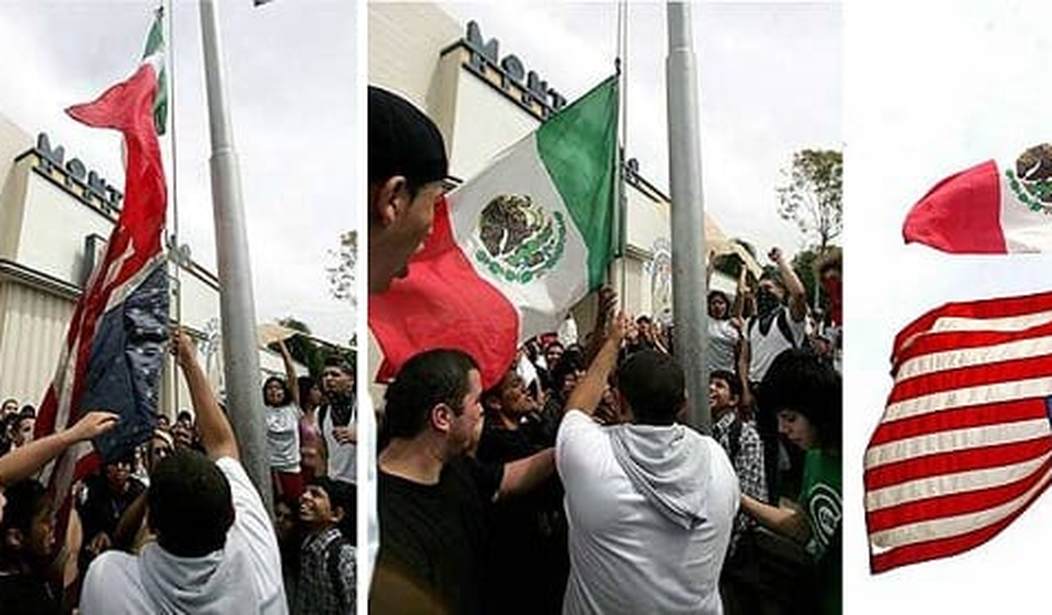 Yesterday, the US Ninth Circuit confirmed a February decision by a panel of that court that school officials can forbid students who are American citizens from wearing American flag themed clothing to school because of the threats made against those students (see earlier RedState coverage here and here).
Yesterday, the US Ninth Circuit confirmed a February decision by a panel of that court that school officials can forbid students who are American citizens from wearing American flag themed clothing to school because of the threats made against those students (see earlier RedState coverage here and here).
Rejecting free speech arguments from parents, Republican lawmakers and conservative groups, a federal appeals court on Wednesday refused to reconsider a ruling that found a South Bay high school had the legal right to order students wearing American-flag adorned shirts to turn them inside out during a 2010 Cinco de Mayo celebration.
The 9th U.S. Circuit Court of Appeals let stand its February ruling in favor of Live Oak High School administrators, who argued that a history of problems on the Mexican holiday justified the decision to act against the American flag-wearing students. Officials at the Morgan Hill school ordered the students to either cover up the shirts or go home, citing past threats and campus strife between Latino and white students that raised fears of violence.
The facts in this case are sad, from the dissent (pdf) to the decision by Judge Diarmuid O’Scanliann:
On May 5, 2010, Cinco de Mayo, a group of Caucasian students at Live Oak High School (“Live Oak”) wore shirts depicting the American flag to school.1 Dariano v. Morgan Hill Unified Sch. Dist., No. 11-17858, amended slip op. at 22 (9th Cir. 2014). In the six preceding years, there had been at least thirty fights on campus, some between gangs and others between Caucasians and Hispanics, id. at 21, although the district court made no findings as to whether these fights were related to ethnic tensions, Dariano v. Morgan Hill Unified Sch. Dist., 822 F. Supp. 2d 1037, 1043 (N.D. Cal. 2011). A year earlier, during Cinco de Mayo 2009, a group of Caucasian students and a group of Mexican students exchanged profanities and threats. Dariano, amended slip op. at 21. When the Caucasian students hung a makeshift American flag and began chanting “U–S–A,” Assistant Principal Miguel Rodriguez intervened and asked the Mexican students to stop using profane language, to which one Mexican student responded, “But Rodriguez, they are racist. They are being racist. F*** them white boys. Let’s f*** them up.” Id.
One year later, during Cinco de Mayo 2010, three of the students wearing American flag shirts were confronted by other students about their choice of apparel. Id. at 22. One student asked M.D., a plaintiff in this case, “Why are you wearing that? Do you not like Mexicans[?]” Id. A Caucasian student later told Assistant Principal Rodriguez before brunch break, “You may want to go out to the quad area. There might be some—there might be some issues.” Id. During the break, a Mexican student informed Rodriguez that she was concerned “there might be problems” due to the American flag shirts. Id. Another asked Rodriguez why Caucasian students “get to wear their flag out when we don’t get to wear our flag?” Id. (alterations omitted). Principal Nick Boden instructed Rodriguez to have the students wearing the American flag shirts turn their shirts inside out or take them off. Id.
This is a classic case of the heckler’s veto, something that is sadly prevalent on the left as Tolerance supplants God as the source of our morality, where a speaker is silenced by the government if a sufficiently loud opposition can be found. In this case, the students wearing the flag were faced with threats of violence and rather than punishing the racist thugs who were making the threats, free speech was prohibited. All of this in defense of a “holiday” that has less cultural legitimacy than Kwanza.
Back to Judge O’Scanlainn:
With respect, I suggest that the panel’s opinion misinterprets Tinker’s own language, our precedent, and the law of our sister circuits. The panel claims that the source of the threatened violence at Live Oak is irrelevant: apparently requiring school officials to stop the source of a threat is too burdensome when a more “readily-available” solution is at hand, id. at 28, namely, silencing the target of the threat. Thus the panel finds it of no consequence that the students exercising their free speech rights did so peacefully, that their expression took the passive form of wearing shirts, or that there is no allegation that they threatened other students with violence.2 The panel condones the suppression of the students’ speech for one reason: other students might have reacted violently against them. Such a rationale contravenes fundamental First Amendment principles.
If this decision stands, the implications are terrifying. As social conservatives are already under pressure to shut up and get with the program on issues such as homosexual marriage, it is not difficult to see where a court could ban a speaker advocating the unique place of real marriage in society because of threats of violence from a homosexual group. Had this philosophy been in effect in the 1950s and early 1960s, Jim Crow would still be the law of the land and Civil Rights workers would have been silenced or imprisoned because of Klan threats. This decision is a odds with decisions from two other Circuit Courts and so will probably end up before the Supreme Court… where our fate will rest on Anthony Kennedy’s manly shoulders.














Join the conversation as a VIP Member